Greek and Roman statues were often painted, but assumptions about race and aesthetics have suppressed this truth. Now scholars are making a color correction.
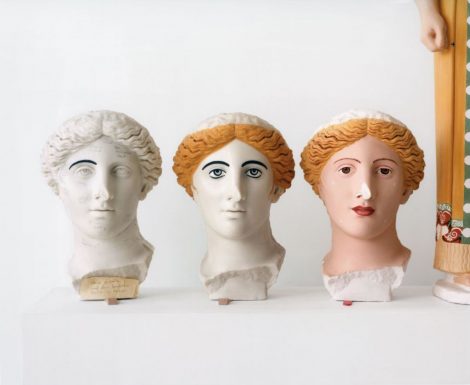
Mark Abbe was ambushed by color in 2000, while working on an archeological dig in the ancient Greek city of Aphrodisias, in present-day Turkey. At the time, he was a graduate student at New York University’s Institute of Fine Arts, and, like most people, he thought of Greek and Roman statues as objects of pure white marble. The gods, heroes, and nymphs displayed in museums look that way, as do neoclassical monuments and statuary, from the Jefferson Memorial to the Caesar perched outside his palace in Las Vegas.
Aphrodisias was home to a thriving cadre of high-end artists until the seventh century A.D., when an earthquake caused it to fall into ruin. In 1961, archeologists began systematically excavating the city, storing thousands of sculptural fragments in depots. When Abbe arrived there, several decades later, he started poking around the depots and was astonished to find that many statues had flecks of color: red pigment on lips, black pigment on coils of hair, mirrorlike gilding on limbs. For centuries, archeologists and museum curators had been scrubbing away these traces of color before presenting statues and architectural reliefs to the public. “Imagine you’ve got an intact lower body of a nude male statue lying there on the depot floor, covered in dust,” Abbe said. “You look at it up close, and you realize the whole thing is covered in bits of gold leaf. Oh, my God! The visual appearance of these things was just totallydifferent from what I’d seen in the standard textbooks—which had only black-and-white plates, in any case.” For Abbe, who is now a professor of ancient art at the University of Georgia, the idea that the ancients disdained bright color “is the most common misconception about Western aesthetics in the history of Western art.” It is, he said, “a lie we all hold dear.”
In the early nineteen-eighties, Vinzenz Brinkmann had a similar epiphany while pursuing a master’s degree in classics and archeology from Ludwig Maximilian University, in Munich. As part of an effort to determine what kinds of tool marks could be found on Greek marble sculpture, he devised a special lamp that shines obliquely on an object, highlighting its surface relief. When he began scrutinizing sculptures with the lamp, he told me, he “quite immediately understood” that, while there was little sign of tool marks on the statues, there was significant evidence of polychromy—all-over color. He, too, was taken aback by the knowledge that a fundamental aspect of Greek statuary “had been so excluded” from study. He said, “It started as an obsession for me that has never ended.”
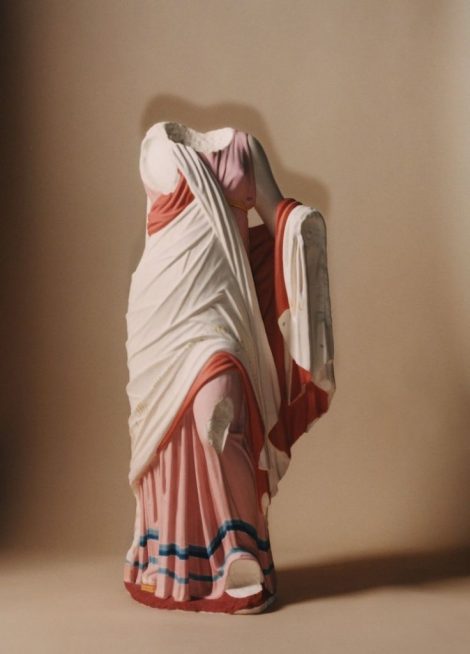
Brinkmann soon realized that his discovery hardly required a special lamp: if you were looking at an ancient Greek or Roman sculpture up close, some of the pigment “was easy to see, even with the naked eye.” Westerners had been engaged in an act of collective blindness. “It turns out that vision is heavily subjective,” he told me. “You need to transform your eye into an objective tool in order to overcome this powerful imprint”—a tendency to equate whiteness with beauty, taste, and classical ideals, and to see color as alien, sensual, and garish.
In the nineteen-nineties, Brinkmann and his wife, Ulrike Koch-Brinkmann, who is an art historian and an archeologist, began re-creating Greek and Roman sculptures in plaster, painted with an approximation of their original colors. Palettes were determined by identifying specks of remaining pigment, and by studying “shadows”—minute surface variations that betray the type of paint applied to the stone. The result of this effort was a touring exhibition called “Gods in Color.” Versions of the show, which was launched in 2003, have been seen by three million museumgoers in twenty-eight cities, including Istanbul and Athens.
The replicas often deliver a shock. A Trojan archer, from approximately 500 B.C., wears tight pants with a harlequin pattern that is as boldly colored as Missoni leggings. A lion that once stood guard over a tomb in Corinth, in the sixth century B.C., has an azurite mane and an ochre body, calling to mind Mayan or Aztec artifacts. There are also reconstructions of naked figures in bronze, which have a disarming fleshiness: copper lips and nipples, luxuriant black beards, wiry swirls of dark pubic hair. (Classical bronze figures were often blinged out with gemstones for the eyes and with contrasting metals that highlighted anatomical details or dripping wounds.) Throughout the exhibition, the colored replicas are juxtaposed with white plaster casts of marble pieces—fakes that look like what we think of as the real thing.
For many people, the colors are jarring because their tones seem too gaudy or opaque. In 2008, Fabio Barry, an art historian who is now at Stanford, complained that a boldly colored re-creation of a statue of the Emperor Augustus at the Vatican Museum looked “like a cross-dresser trying to hail a taxi.” Barry told me, in an e-mail, that he still found the colors unduly lurid: “The various scholars reconstructing the polychromy of statuary always seemed to resort to the most saturated hue of the color they had detected, and I suspected that they even took a sort of iconoclastic pride in this—that the traditional idea of all-whiteness was so cherished that they were going to really make their point that it was colorful.”
But some of the disorientation among viewers comes from seeing polychromy at all. Østergaard, who put on two exhibitions at the Glyptotek which featured painted reconstructions, said that, to many visitors, the objects “look tasteless.” He went on, “But it’s too late for that! The challenge is for us to try and understand the ancient Greeks and Romans—not to tell them they got it wrong.”
Lately, this obscure academic debate about ancient sculpture has taken on an unexpected moral and political urgency. Last year, a University of Iowa classics professor, Sarah Bond, published two essays, one in the online arts journal Hyperallergic and one in Forbes, arguing that it was time we all accepted that ancient sculpture was not pure white—and neither were the people of the ancient world. One false notion, she said, had reinforced the other. For classical scholars, it is a given that the Roman Empire—which, at its height, stretched from North Africa to Scotland—was ethnically diverse. In the Forbes essay, Bond notes, “Although Romans generally differentiated people on their cultural and ethnic background rather than the color of their skin, ancient sources do occasionally mention skin tone and artists tried to convey the color of their flesh.” Depictions of darker skin can be seen on ancient vases, in small terra-cotta figures, and in the Fayum portraits, a remarkable trove of naturalistic paintings from the imperial Roman province of Egypt, which are among the few paintings on wood that survive from that period. These near-life-size portraits, which were painted on funerary objects, present their subjects with an array of skin tones, from olive green to deep brown, testifying to a complex intermingling of Greek, Roman, and local Egyptian populations. (The Fayum portraits have been widely dispersed among museums.)
Bond told me that she’d been moved to write her essays when a racist group, Identity Evropa, started putting up posters on college campuses, including Iowa’s, that presented classical white marble statues as emblems of white nationalism. After the publication of her essays, she received a stream of hate messages online. She is not the only classicist who has been targeted by the so-called alt-right. Some white supremacists have been drawn to classical studies out of a desire to affirm what they imagine to be an unblemished lineage of white Western culture extending back to ancient Greece. When they are told that their understanding of classical history is flawed, they often get testy.
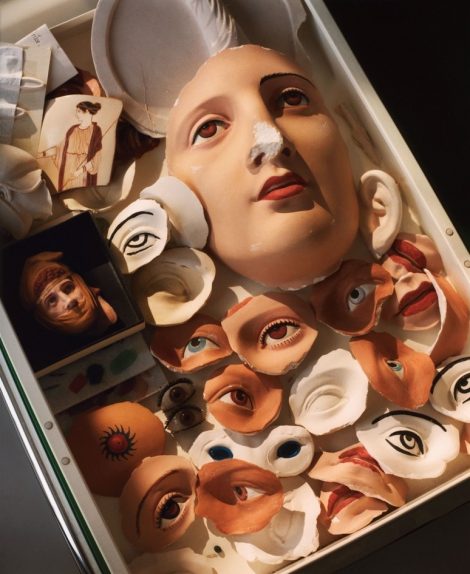
Earlier this year, the BBC and Netflix broadcast “Troy: Fall of a City,” a miniseries in which the Homeric hero Achilles is played by a British actor of Ghanaian descent. The casting decision elicited a backlash in right-wing publications. Online commenters insisted that the “real” Achilles was blond-haired and blue-eyed, and that someone with skin as dark as the actor’s surely would have been a slave. It’s true that Homer describes the hair of Achilles as xanthos, a word often used to characterize objects that we would call yellow, but Achilles is fictional, so imaginative license in casting seems perfectly acceptable. Moreover, several scholars explained online that, though ancient Greeks and Romans certainly noticed skin color, they did not practice systematic racism. They owned slaves, but this population was drawn from a wide range of conquered peoples, including Gauls and Germans.
Nor did the Greeks conceive of race the way we do. Some of the ancients’ racial theories were derived from the Hippocratic idea of the humors. Rebecca Futo Kennedy, a classicist at Denison University, who writes on race and ethnicity, told me, “Cold weather made you stupid but also courageous, so that was what people from the Far North were supposed to be like. And the people they called Ethiopians were thought of as very smart but cowardly. It comes out of the medical tradition. In the North, you have plenty of thick blood. Whereas, in the South, you’re being desiccated by the sun, and you have to think about how to conserve your blood.” Pale skin on a woman was considered a sign of beauty and refinement, because it showed that she was privileged enough not to have to work outdoors. But a man with pale skin was considered unmasculine: bronzed skin was associated with the heroes who fought on battlefields and competed as athletes, naked, in amphitheatres.
In an essay for the online magazine Aeon, Tim Whitmarsh, a professor of Greek culture at the University of Cambridge, writes that the Greeks “would have been staggered” by the suggestion that they were “white.” Not only do our modern notions of race clash with the thinking of the ancient past; so do our terms for colors, as is clear to anyone who has tried to conceive what a “wine-dark sea” actually looked like. In the Odyssey, Whitmarsh points out, the goddess Athena is said to have restored Odysseus to godlike good looks in this way: “He became black-skinned again and the hairs became blue around his chin.” On the Web site Pharos, which was founded, last year, in part to counter white-supremacist interpretations of the ancient world, a recent essay notes, “Although there is a persistent, racist preference for lighter skin over darker skin in the contemporary world, the ancient Greeks considered darker skin” for men to be “more beautiful and a sign of physical and moral superiority.”
Last year, high-school students participating in a summer program at the risdMuseum, in Providence, were so fascinated to learn about polychromy in classical statuary that they made a coloring book allowing gallery visitors to create brightly hued versions of the objects on display. Christina Alderman, who runs the program, told me, “The moment they found out that the statues were originally painted, I just lost them to that idea. They were, like, ‘Wait, are you serious? I’ve played video games set in ancient times, and all I see are white sculptures. I watch movies and that’s all I see.’ It was a real human response—they kind of felt they’d been lied to.”
The idealization of white marble is an aesthetic born of a mistake. Over the millennia, as sculptures and architecture were subjected to the elements, their paint wore off. Buried objects retained more color, but often pigments were hidden beneath accretions of dirt and calcite, and were brushed away in cleanings. In the eighteen-eighties, Russell Sturgis, an American art critic, visited the Acropolis, in Athens, and described what happened after objects were unearthed: “The color of all these soon began to fall and vanish. The beautiful statue first described lay on a table in the museum on the Acropolis in May, 1883, and already some of its color had been shaken off; for as it lay it was surrounded by a little deposit of green, red and black powder which had fallen from it.” Paint that survived was sometimes concealed in recesses: between strands of hair, or inside navels, nostrils, and mouths.
In time, though, a fantasy took hold. Scholars argued that Greek and Roman artists had left their buildings and sculptures bare as a pointed gesture—it both confirmed their superior rationality and distinguished their aesthetic from non-Western art. Acceptance of this view was made easier by the fact that ancient Egyptian sculptures looked very different: they tended to retain brilliant surface color, because the dry climate and the sand in which they were interred did not result in the same kind of erosion. But, as Østergaard put it to me, “nobody has a problem hailing Nefertiti as a spectacular piece of world art, and nobody says that it’s unfortunate that it’s painted. Because it’s not Western, it’s perfectly O.K. for it to be polychrome. But let’s not have it in our part of the world, because we’re different, aren’t we?”
Starting in the Renaissance, artists made sculpture and architecture that exalted form over color, in homage to what they thought Greek and Roman art had looked like. In the eighteenth century, Johann Winckelmann, the German scholar who is often called the father of art history, contended that “the whiter the body is, the more beautiful it is,” and that “color contributes to beauty, but it is not beauty.” When the ancient Roman cities of Pompeii and Herculaneum were first excavated, in the mid-eighteenth century, Winckelmann saw some of their artifacts in Naples, and noticed color on them. But he found a way around that discomfiting observation, claiming that a statue of Artemis with red hair, red sandals, and a red quiver strap must have been not Greek but Etruscan—the product of an earlier civilization that was considered less sophisticated. He later concluded, however, that the Artemis probably was Greek. (It is now thought to be a Roman copy of a Greek original.) Østergaard and Brinkmann believe that Winckelmann’s thinking was evolving, and that he might eventually have embraced polychromy, had he not died in 1768, at the age of fifty, after being stabbed by a fellow-traveller at an inn in Trieste.
The cult of unpainted sculpture continued to permeate Europe, buttressing the equation of whiteness with beauty. In Germany, Goethe declared that “savage nations, uneducated people, and children have a great predilection for vivid colors.” He also noted that “people of refinement avoid vivid colors in their dress and the objects that are about them.”
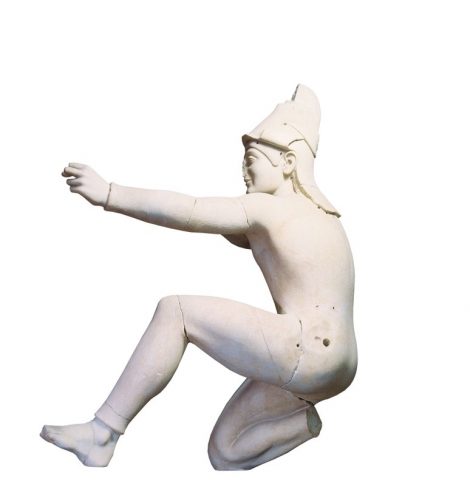

In the nineteenth century, a series of major excavations should have toppled the monochrome myth. In Rome, the architect Gottfried Semper used scaffolding to examine Trajan’s Column, and reported finding myriad traces of color. Victorian excavations of the Acropolis turned up some painted reliefs, sculptures, and marble gutters. The Augustus of Prima Porta and the Alexander Sarcophagus retained bold hues when they were discovered, as contemporaneous paintings of them confirm.
In a catalogue essay for an 1892 exhibition at the Art Institute of Chicago, the classical scholar Alfred Emerson said of polychromy that “literary testimony and the evidence of archeology are too strong and uniform to admit of quibble or doubt.” Nevertheless, Emerson continued, “so strong was the deference for the Antique, learned from the Italian masters of the Renaissance, that the accidental destruction of the ancient coloring” had been “exalted into a special merit, and ridiculously associated with the ideal qualities of the highest art”—from “lofty serenity” to “unsullied purity.”
This ardor for whiteness was so intense that the evidence didn’t stand a chance. Scholars who continued to discuss polychromy were often dismissed. Auguste Rodin is supposed to have pounded his chest and said, “I feel it here that they were never colored.” Sculpture and painting had become increasingly independent disciplines, and artists who tried to merge the two were met with scorn. In the eighteen-fifties, when the British artist John Gibson, a proponent of polychromy, showed his delicate “Tinted Venus”—the goddess’s body is mostly white, but she has muted golden hair and cornflower-blue eyes—a titillated reviewer described the figure as “a naked, impudent Englishwoman.”
As the artist and critic David Batchelor writes in his 2000 book, “Chromophobia,” at a certain point ignorance becomes willful denial—a kind of “negative hallucination” in which we refuse to see what is before our eyes. Mark Abbe, who has become the leading American scholar of ancient Greek and Roman polychromy, believes that, when such a delusion persists, you have to ask yourself, “Cui bono?”—“Who benefits?” He told me, “If we weren’t benefitting, we wouldn’t be so invested in it. We benefit from a whole range of assumptions about cultural, ethnic, and racial superiority. We benefit in terms of the core identity of Western civilization, that sense of the West as more rational—the Greek miracle and all that. And I’m not saying there’s no truth to the idea that something singular happened in Greece and Rome, but we can do better and see the ancient past on a broader cultural horizon.”
In the twentieth century, appreciation for ancient polychromy and decoration went further into eclipse—largely on aesthetic, rather than racial, grounds. Modernism lauded the abstraction of white forms and derided earthy verisimilitude in sculpture. In a 1920 essay titled “Purism,” the architect Le Corbusier wrote, “Let us leave to the clothes-dyers the sensory jubilation of the paint tube.” In Italy and Germany, Fascist artists created white marble statuary of idealized bodies. After the Second World War, European architects sought a neutral common heritage by promoting the modest virtues of spare white spaces, such as the parliamentary building in Bonn.
Over the centuries, many art restorers and dealers felt obliged to vigorously scrub Greek and Roman objects, so as to enhance their marmoreal gleam—and their collectibility. Mark Bradley, a classicist at the University of Nottingham, believes that in some cases restorers were merely trying to remove residue left by oil lamps that had lit galleries before the advent of electricity. But, he noted in an e-mail, many museums propagated “an enduring Renaissance conspiracy” to “eradicate traces of paint.” In the nineteen-thirties, restorers at the British Museum polished the Elgin marbles, the most treasured sculptures from the Acropolis, until they were as white and shiny as pearls.
One day in July, Abbe was in Bloomington, Indiana, peering at two Roman busts: one of the militaristic Emperor Septimius Severus and one of his learned wife, Julia Domna. The busts belong to Indiana University’s Eskenazi Museum, which is closed for renovation, and Abbe was examining them in a storage facility. The sculptures, made from a creamy white marble, appeared to have negligible speckles and stains. But Abbe knew better. He had examined their surfaces with a powerful microscope and with infrared and UV light, and had discovered rich purples, blues, and pinks.
In 2007, Giovanni Verri, who now teaches conservation at the Courtauld Institute, in London, figured out how to confirm the presence of an ancient pigment known as Egyptian blue. It has a remarkable capacity for luminescence under infrared light, and Verri found that in digital photographs taken under such light it glistened like ice crystals. Abbe had seen these sparkles on the two Roman busts. Now he was planning to take samples of the pigments he’d detected, so that they could be chemically analyzed.
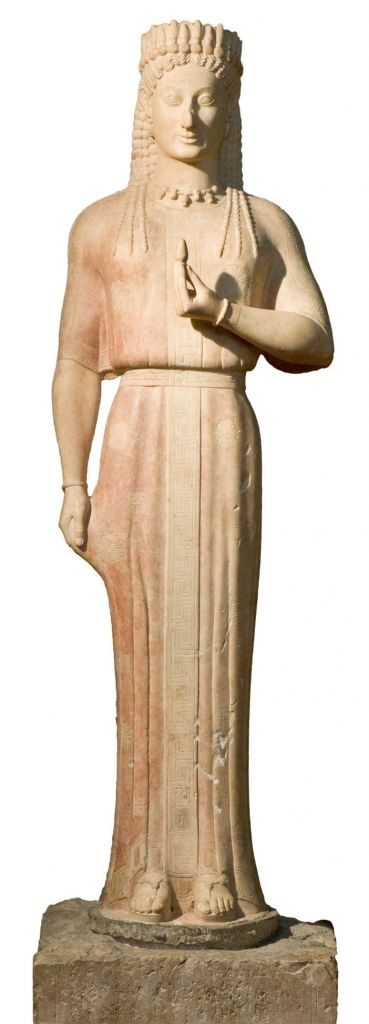
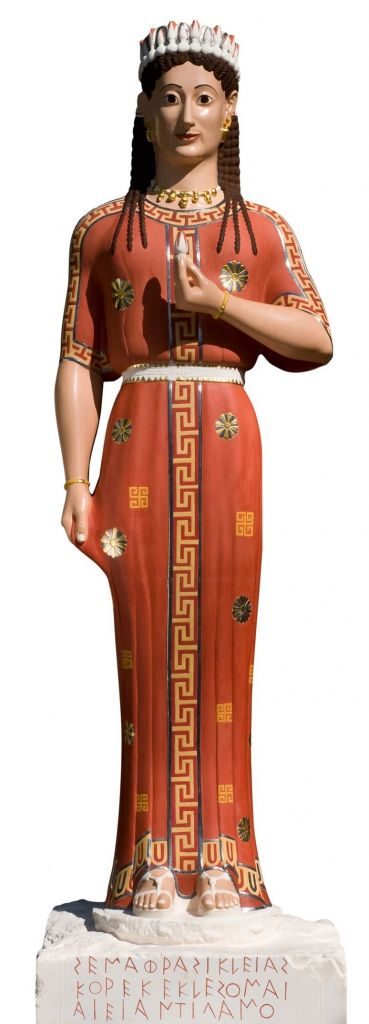
A conservation scientist from the Indianapolis Museum of Art, Gregory Dale Smith, would undertake the extraction of the samples, the largest of which would be the size of the period at the end of this sentence. He would use an array of fantastical tools, including an eye surgeon’s scalpel, a tungsten needle with a tip six microns wide, and a brush with a single bristle, made from the hair of a deer. Smith, who arrived at the storage facility later that afternoon, told me that he had skipped coffee that day—he needed to have the steadiest of hands.
Julie Van Voorhis, an art-history professor at Indiana who is researching the busts, had joined Abbe and me, along with Juliet Graver Istrabadi, the ancient-art curator from the Eskenazi Museum. For a while, the four of us stood in a polite semicircle and gazed at the statues, as though we were guests at their party and they were about to give a toast.
Abbe told me, “From basically 1960 to 2000, people were just, like, ‘Yeah, the color’s there, but you can’t do anything with it—there’s not enough there, it’s too fragmentary.’ ” But in recent years it’s become easier to detect many colors, using noninvasive technologies such as X-ray fluorescence analysis (which can identify the elements in pigments). Ancient organic dyes—such as Tyrian purple, made from the glands of sea snails—are harder to identify, but scholars have had some success using surface-enhanced Raman spectroscopy, which measures molecular vibrations. Armed with these technologies, curators and conservators are starting to “reëxcavate in our own museums,” as one scholar put it to me—taking objects that were presumed to be colorless and looking at them anew.
Abbe, who is forty-five, tall, and slim, was wearing a dapper dark suit and a narrow floral tie. He has a springy energy that reminded me of an actor playing a brainy young inventor. He told me that, when he first examines a sculpture for signs of polychromy, he looks at it for hours, aided by a device that involves a magnifying glass and an L.E.D. light affixed to a headband. He gave me one to put on; it looked like a dorky version of a miner’s lamp. “I try to convince everyone that they need to buy these for when they go to museums,” he said. (He advises people who actually do wear the device in galleries to put their hands behind their backs while peering closely at objects, so that guards don’t freak out.)
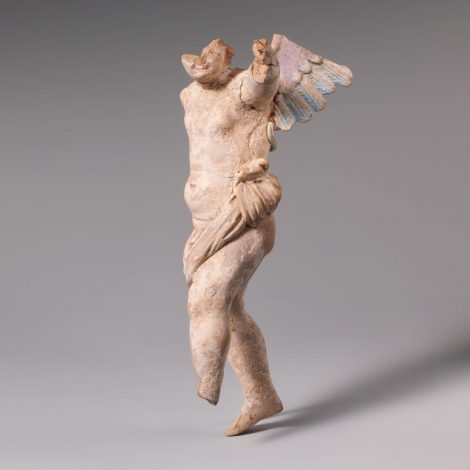
As I walked around the busts, he told me, “You can get much closer. Once your eyes are properly adjusted, you can go in and see details.” I leaned in and looked at the emperor’s cloak; tiny teardrop shapes, in the deep purplish blue of old ink stains, swam into view on a white surface.
“So blue and white is the base layer,” Abbe said over my shoulder. “And the white part seems to be painted with lead white, one of the most opaque whites. And then they’re washing that over with a paint pigment that seems to have a number of elements—it seems to have Egyptian blue in it, and it seems to have a mercury-rich red pigment, probably cinnabar. That’s a good example of how they’re layering.”
Abbe and Van Voorhis are interested in finding out not just which colors the ancients favored but what techniques they used to apply paint: how sculptors polished stone surfaces in preparation for pigment, how they added highlights and shading to faces. Learning more about these methods will help scholars create more nuanced facsimiles, and will also illuminate how painting and sculpting worked in tandem in the ancient world. Skeptics of polychromy question why Greek and Roman artists would have sculpted with such beautiful materials—Parian marble, which was commonly used, has a prized translucence—and then painted over the surface, or bedazzled it with gilt and jewels. But if painters and sculptors worked together as partners, with an understanding of how tactically applied color could enhance a work’s luminosity, polychromy makes more aesthetic sense.
Abbe said, “We have this wonderful anecdote from Praxiteles, the Greek sculptor from the fourth century B.C. When he’s asked which of his sculptures he liked the best, he names those that the premier painter of the day, Nicias, ‘applied his hand to.’ ” He noted that, in the ancient Roman Empire, statues would not have been sequestered in art galleries—they would have been on the streets and in people’s homes. Figures that were deftly painted would have looked eerily lifelike, particularly in low and flickering light. “There’s a real aesthetic, especially in the Roman period, for the visual trick,” he said. “When you went into a place, the divide between what was sculpture and what was actual life was fluid, and highly theatrical. You go to a dinner party in Pompeii, and there are statues of nude homoerotic youths, in the old, noble Greek tradition. And then there are actual slave boys that look just like those well-tanned bronzes, and at first they’re standing still. And then they move, the And then they move, the same way the sculptures seem to move in the reflections of pools and fountains. So, you know, you’ve had a little bit to drink, and you’re negotiating this—”
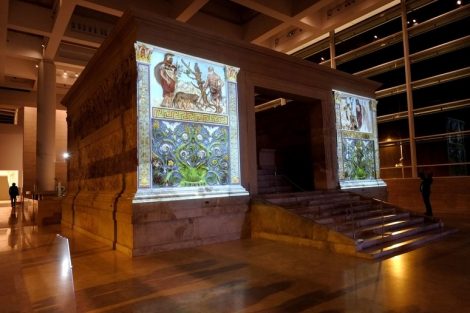
Van Voorhis joined in the reverie: “You’re calling over your slave boy, but it happens to be a statue. And then the slave boy comes from the other side and refills your cup.”
At one point, Abbe said, “The modern art gallery, you could say, kills these things—transforms them into something they’re not.”
One of the advantages of establishing scientific methods to prove that classical objects were polychrome is that they provide archeologists with a protocol—a formal way to look for color before cleaning an artifact. Significant Greek and Roman finds are still being made. Abbe noted that a set of Roman historical friezes recently found in Nicomedia, Turkey, are “awash in purple.”
Abbe and Van Voorhis lamented that, even now, such objects are sometimes mercilessly cleaned. “Remember how they would hose statues down in the courtyard?” Van Voorhis asked Abbe, recalling an excavation in Turkey that they’d both worked on.
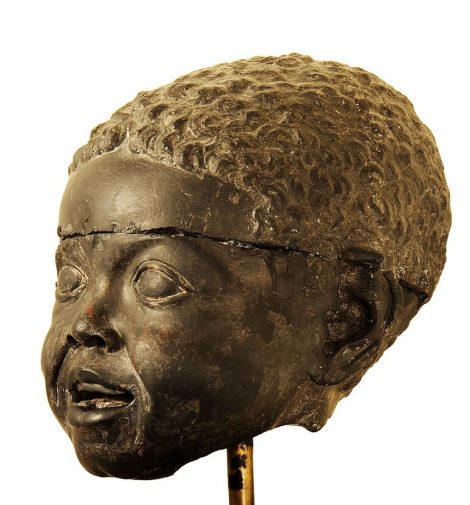
“Like you’d hose down your wheelbarrow,” Abbe said. At times, he added, the impulse to clean is less about a dislike of color and more about “the excitement of discovery”: “You want to see what you’ve got. Archeology is a slow business. Then, imagine, it’s the last day, and you finally find something. The first thing you want to do is make it legible.” This impulse, he said, must be checked: “You should treat a discovery like a medical situation. Treat it like triage. What you want to do is stabilize the patient. Less is more. Take the thing, wrap it up in something like neutral cotton gauze, and put it on a shelf in a stable place. Then call us, and we will come and do the micro-excavation of the surface.” This process needs to happen relatively quickly, because, after extraction, the soil clinging to an object dries, and “the paint layers literally delaminate with it,” leaving a denuded object and “a painting in reverse” adhering to scattered flakes of soil.
As we examined the bust of Julia, Van Voorhis pointed out a tendril of hair peeking out from under her wig. This made it clear that she was wearing the wig for fashion, not to cover up baldness. Her face was so carefully modelled that you could see where her cheek was beginning to sag slightly. She had horizontal creases encircling her neck—Venus rings, I learned they were called—and a delightful unibrow, both of which connoted desirability. All this humanizing detail had been conveyed purely through form. I wondered if Abbe ever regretted having to see such sculptures, in his mind’s eye, saturated in the bright colors that many people find kitschy.
The first time I saw a statue that had been painted to approximate ancient polychromy, I was in Nashville, of all places. In 1897, a full-scale replica of the Parthenon was erected in a city park there, and inside it is an enormous statue of Athena. To my eye, the figure, which was painted and gilded in the two-thousands, looked awful: her golden robes had a blinding shimmer, her eyes were a doll-like blue, and her lips could have beckoned from a lipstick ad. It reminded me of a Jeff Koons piece that revels in its tackiness. Yet Abbe assured me that the colorized Athena was consistent with the aesthetics of the lost original, from the fifth century B.C.
Some of the painted replicas that I saw subsequently seemed more subtle and persuasive. Nevertheless, as much as I thought that it was important to acknowledge polychromy, I still sometimes preferred the ghostly elegance of white marble.
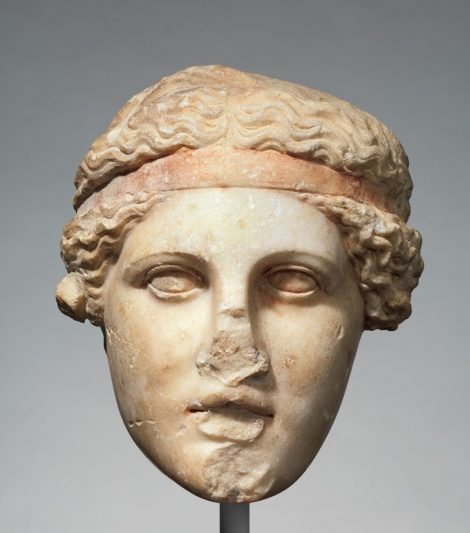
When I shared this feeling with Abbe, he said, “We can have our cake and eat it, too. We can still look at these things and admire them as monochromatic, neoclassical works. We can also recover the ancient aesthetics and correct an untruth.” He promised that not even the most fervent champion of polychromy was going to start slathering contemporary paint on ancient objects.
So how should we represent the colors of the classical world in museums? The reality-television, big-reveal style of the “Gods in Color” exhibition is certainly effective at upending our preconceptions. As Østergaard said, “A physical object right next to an original gives the public a real ‘Aha!’ moment. It’s spectacularly successful as a means of communication.”
But Abbe, like many scholars I talked to, wasn’t crazy about the reconstructions in “Gods in Color.” He found the hues too flat and opaque, and noted that plaster, which most of the replicas are made from, absorbs paint in a way that marble does not. He was also bothered by the fact that the statues “all look fundamentally the same, whereas styles would have differed enormously.”
The Brinkmanns have made several replicas in synthetic and real marble—an expensive undertaking—and these do reflect light somewhat better than the plaster models. Cecilie Brøns, who currently heads a project at the Glyptotek called Tracking Colour, which is investigating all the museum’s ancient pieces for traces of color, admires the Brinkmanns’ reconstructions but said she worries that museumgoers accept them too literally. The replicas were best appreciated as interpretations, she said, adding, “Reconstructions can be difficult to explain to the public—that these are not exact copies, that we can never know exactly how they looked.”
Giovanni Verri, of the Courtauld Institute, told me, “Knowing the particular pigments and the painting materials is useful, but it’s not the sum of the painting. There is the technique component—the style, the sensibility.” To paint exactly as an ancient painter did would require a psychic form of time travel. “We have so much knowledge that those painters would not have had,” he said. “We have experienced two thousand years of history, and art history, that would be extremely difficult to forget.”
Verri, like Abbe and others in the field, believes that digital reproductions—computer animations and the like—can offer advantages that physical ones do not. They can be revised as new information becomes available, and they can also show multiple possibilities of how an object might have looked. Verri created such a digital reproduction a few years ago, after he spent time investigating the traces of polychromy on the Treu Head—an idealized female figure, sculpted in the second century A.D., that is in the collection of the British Museum. Verri performed what he called “a digital face transplant.” He identified pigments that had originally covered the sculpture: Egyptian blue mixed into pinkish skin tones and the whites of the eyes; yellow and red ochre in the hair; rose-colored madder lake for the lips. He also studied and mimicked the sophisticated painting techniques used in the Fayum portraits. The result is refined and naturalistic.
When the Eskenazi Museum reopens, in a year or two, it will host a special exhibition featuring the busts of Severus and Julia. To show the original polychromy, Abbe and Van Voorhis have considered projecting colored light on the statues for part of the day. (A set of friezes at the Ara Pacis museum, in Rome, have been presented this way, to pleasing effect.) Another idea is to present a video animation in which the color gradually appears on the two Roman busts, suggesting how successive layers of paint might have been applied.
Abbe and Van Voorhis will have to engage in some speculation, particularly when it comes to hair color and skin tone. They have no reason to believe that there wasn’t pigment on the skin or hair of the busts, but they have not found any traces of it. “The absence of evidence is not evidence of absence,” Abbe wrote to me, in an e-mail. “Classic neoclassical assumption!”
Later, in another e-mail, Abbe pointed out that much of the Roman élite “came from diverse-looking stock—Berber, Arab, Transylvanian, Danubian, Spanish, etc.” He also noted that sculptures of African people from the ancient world were sometimes carved from black stones, such as basalt, and then painted with reddish-brown pigments to create a lifelike effect. One such example, at the Museum für Kunst und Gewerbe, in Hamburg, is the head of a young boy, from the first century B.C.; patches of mahogany-colored paint can still be seen on the nose and the cheeks.
Severus and Julia were Romans, but neither was of Italic descent. Severus was of Berber origin, from an élite family in Libya. Julia came from a priestly family in Emesa, Syria. A panel painting of the couple, known as the Berlin Tondo, has survived: Severus has a chestnut-brown complexion and a grizzled gray beard; Julia is paler, with dark hair and eyes. The Tondo will help guide Abbe and Van Voorhis in their work on the busts, just as the Fayum portraits aided Verri.
The easiest, and cheapest, way for museums to address the fact of polychromy is to say more about it in their labelling. One day in July, Gina Borromeo, the curator of ancient art at the risd Museum, walked me through the Greek and Roman galleries, and pointed out a label that she’d written in 2009: “The surviving traces of reddish pigment, still visible in the hair of this figure, reflect the fact that most ancient statues were originally quite vividly painted.” But Borromeo believes that nothing can match the power of displaying a polychrome work that has retained its original hues. In 2016, she successfully lobbied to acquire an Etruscan urn that still has much of its original color.
Vinzenz Brinkmann, who now heads the antiquities department of the Liebieghaus sculpture collection, in Frankfurt, told me that viewing classical sculptures in color does far more than expand your notion of what such objects originally looked like; it helps you understand that “everything that seems to be so clearly and firmly set is not always so clearly and firmly set.” In other words, he said, seeing these colors affects people’s understanding of themselves. With a small chuckle, he added, “And, for us, this is beautiful.” ♦
Margaret Talbot is a staff writer at The New Yorker and the author of “The Entertainer: Movies, Magic and My Father’s Twentieth Century.”

You must be logged in to post a comment Login